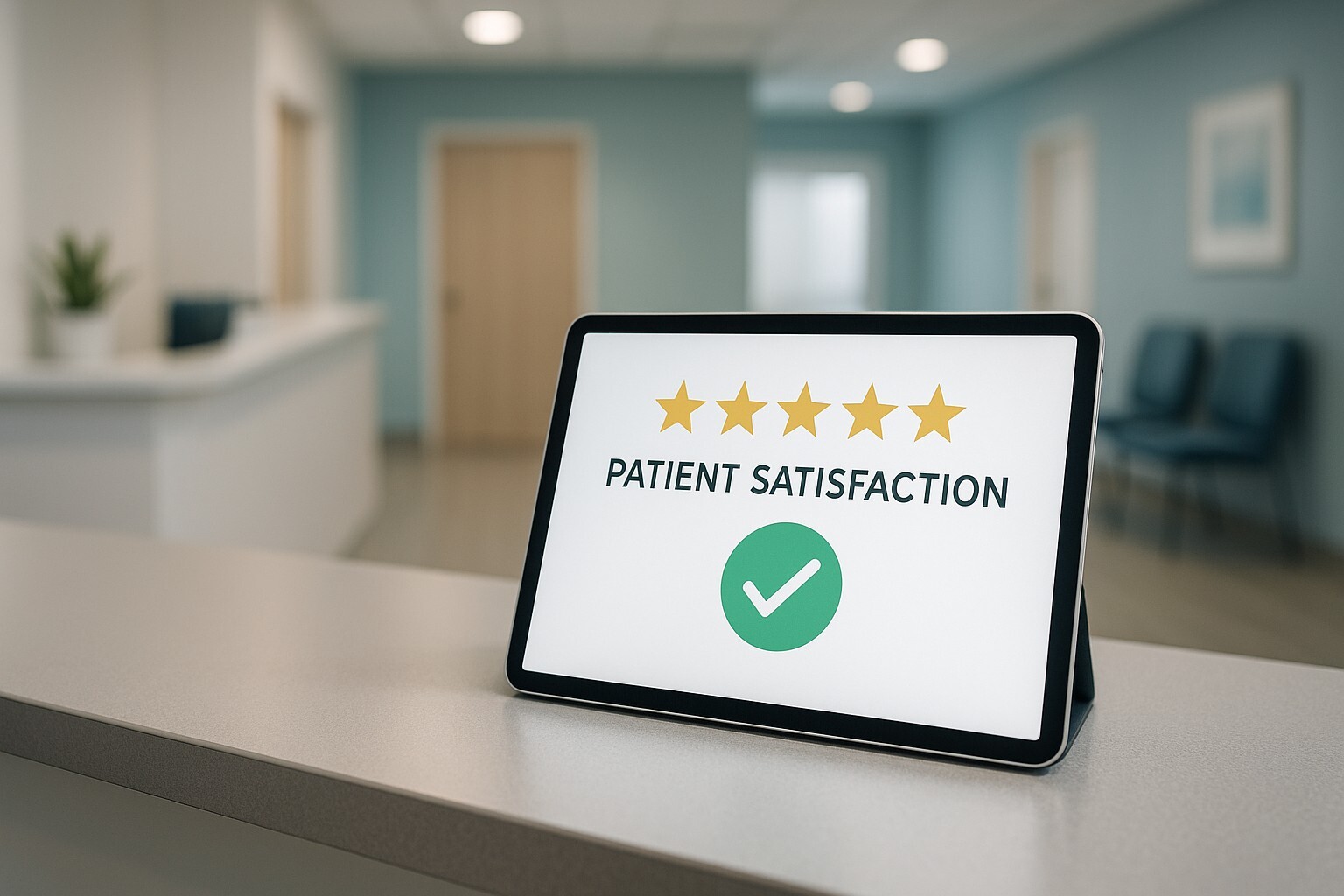9 min read
Types of Patient Satisfaction Surveys and their Uses to Improve Healthcare and Patient Retention
Alvin Amoroso : 7/23/25 9:08 AM

Understanding the different types of patient satisfaction surveys and their uses is fundamental for any healthcare provider aiming to deliver exceptional care in 2025. These surveys are not one-size-fits-all; they are specialised instruments designed to measure different aspects of the patient journey. Using the right survey for the right purpose allows you to gather targeted, actionable feedback. This guide provides a definitive overview of the 10 most important survey types, detailing exactly what they are and, crucially, their primary uses—from fulfilling regulatory mandates and improving operational efficiency to boosting patient loyalty and optimising new technology. By mastering these tools, you can move from simply collecting data to strategically using feedback to drive meaningful improvements across your organisation.
In the current value-based healthcare system, the strategic use of patient feedback is non-negotiable. The data derived from these surveys directly impacts financial reimbursements, public reputation, and clinical quality improvement cycles. A common mistake is to deploy a generic survey and hope for the best. A far more effective approach is to first define your goal—is it to reduce patient wait times, assess the quality of a new telehealth service, or benchmark your hospital against national standards?—and then select the specific survey type designed for that use. This targeted methodology ensures the insights you gather are relevant, clear, and can be translated directly into an effective action plan.tgi
The Core Framework: Categorizing Types of Patient Satisfaction Surveys by Their Intended Use
Before we detail the specific types of patient satisfaction surveys, it's useful to categorize them by their overarching purpose and timing. This framework helps in building a comprehensive feedback strategy.
The most common distinction is between transactional and relationship surveys. This categorization is based entirely on their intended use.
- Use Case: Pinpointing specific service issues. For this, you would use a transactional survey. These are sent immediately after a specific interaction, like a clinic visit, a hospital discharge, or a call with your billing office. Their use is to capture fresh, in-the-moment feedback about a single touchpoint, making them highly effective for diagnosing and fixing operational problems.
- Use Case: Measuring long-term loyalty and overall perception. For this, a relationship survey is the correct tool. Sent periodically (e.g., quarterly or annually), their use is to gauge a patient's cumulative experience and overall feeling about your brand. They are excellent for tracking long-term trends and understanding the big-picture drivers of patient loyalty. The Net Promoter Score (NPS) is a prime example.
Another key distinction is standardized vs. custom-built surveys.
- Use Case: Benchmarking against industry standards. When you need to compare your performance to regional or national averages, you must use a standardized survey. Instruments like HCAHPS are developed by external bodies, ensuring data consistency and comparability across the industry.
- Use Case: Investigating unique operational goals. To get feedback on a new initiative, a specific department, or a unique aspect of your practice, you would use a custom-built survey. This allows you to ask targeted questions that no standardized tool would include, giving you complete flexibility.
A robust feedback programme uses a mix of these categories, selecting the right tool for each specific strategic use.
A Deep Dive: 10 Key Patient Satisfaction Survey Types and Their Uses
Here, we explore the essential survey types in detail, outlining what each one is and its most important applications in a healthcare setting.
Type 1: HCAHPS (Hospital Consumer Assessment of Healthcare Providers and Systems) Survey
- What It Is: A 29-question, government-mandated survey for acute care hospitals in the U.S. It is the national standard for collecting patients' perspectives on their inpatient hospital experience.
- Primary Uses:
- Regulatory Compliance & Reimbursement: Fulfilling the mandatory reporting requirements for the Centers for Medicare & Medicaid Services (CMS). HCAHPS scores can directly impact a hospital's payments under the Value-Based Purchasing program.
- Public Reporting & Reputation Management: The results are publicly posted on the Care Compare website, allowing patients to compare hospitals. This transparency directly influences consumer choice and hospital reputation.
- System-Wide Benchmarking: Using the standardized data to compare your hospital's performance against state and national averages across key domains like nurse communication, doctor communication, and hospital cleanliness.
Type 2: Net Promoter Score (NPS) Survey
- What It Is: A single-question survey asking, "On a scale of 0-10, how likely are you to recommend our practice to a friend or family member?" It measures patient loyalty by categorising respondents into Promoters, Passives, and Detractors.
- Primary Uses:
- Measuring and Improving Patient Retention: NPS is a leading indicator of patient loyalty and retention. Tracking the score over time directly measures your success at keeping patients.
- Identifying Service Recovery Opportunities: Immediately flagging "Detractors" (scores 0-6) allows staff to follow up, address their specific issues, and prevent patient churn.
- Leveraging Promoters for Growth: Identifying "Promoters" (scores 9-10) creates a list of loyal patients who can provide positive reviews and referrals, driving practice growth.
Type 3: CG-CAHPS (Clinician & Group) Survey
- What It Is: The outpatient equivalent of the HCAHPS survey. It is designed to measure patient experiences with primary care providers and specialists in clinics and group practices.
- Primary Uses:
- Improving Ambulatory Care Operations: Gathering specific feedback on outpatient experiences like ease of scheduling appointments, communication with clinicians, and care coordination.
- Benchmarking for Clinics: Allowing individual practices and physician groups to compare their performance against other outpatient facilities.
- Pay-for-Performance Programmes: The data is increasingly used by commercial and public payers in pay-for-performance and quality improvement initiatives.
Type 4: Post-Discharge Surveys
- What It Is: A transactional survey sent to patients within 24-72 hours after they have been discharged from a hospital or surgery centre.
- Primary Uses:
- Reducing Hospital Readmissions: Identifying patients who are confused about their medications or follow-up instructions. This allows for timely clinical intervention to prevent complications that could lead to a preventable readmission.
- Assessing Transitional Care Quality: Evaluating the effectiveness of the discharge planning process and ensuring a safe transition from the hospital back to the patient's home, which improves patient trust and retention.
- Improving Patient Safety: Checking for post-procedure complications or issues with medication adherence.
Type 5: Telehealth Experience Surveys
- What It Is: A survey specifically designed to get feedback on a virtual care visit. It assesses both the technical and clinical aspects of the telehealth experience.
- Primary Uses:
- Optimising Virtual Care Platforms: Gathering user feedback on the usability of the telehealth software, video/audio quality, and the ease of logging in to ensure a frictionless experience.
- Improving "Webside Manner": Providing feedback to clinicians on their virtual communication and engagement skills to ensure a positive patient-provider interaction.
- Driving Adoption and Retention: A seamless telehealth service encourages future use and retains patients who value convenience.
Type 6: Custom General Satisfaction Questionnaires
- What It Is: A flexible survey that a practice designs itself to investigate specific areas of interest not covered by standardized tools.
- Primary Uses:
- Diagnosing Specific Operational Issues: Creating a short survey to get to the bottom of a known problem, such as long wait times, billing confusion, or issues with front desk staff.
- Evaluating New Services or Initiatives: Gauging patient satisfaction with a new service line, a newly renovated facility, or a new workflow process.
- Deep-Diving into Departmental Performance: Deploying different custom surveys for different departments (e.g., radiology, physical therapy) to get targeted feedback.
Type 7: Emergency Department (ED) Satisfaction Surveys
- What It Is: A specialised survey that focuses on the unique, high-stress environment of the Emergency Department.
- Primary Uses:
- Managing Wait Time Perception: Gathering feedback on how well staff communicate delays, which is often more important than the actual wait time itself.
- Improving Communication in Crisis: Assessing how clearly doctors and nurses explained conditions and treatments to patients and their families in a stressful setting.
- Enhancing Triage and Patient Flow: Using feedback to identify bottlenecks in the ED process from arrival to admission or discharge.
Type 8: Patient Health Questionnaire (PHQ-9) & Other PROMs
- What It Is: While technically a Patient-Reported Outcome Measure (PROM), the PHQ-9 (which screens for depression) and similar tools are used to measure an outcome that is integral to satisfaction: the patient's own sense of well-being.
- Primary Uses:
- Integrating Mental and Physical Health: Using the survey to demonstrate a commitment to holistic care, which significantly boosts overall patient satisfaction and trust.
- Tracking Treatment Efficacy: Using changes in a patient's PROM score over time as a key indicator of treatment success, from the patient's own perspective.
- Facilitating Patient-Provider Dialogue: Using the survey results as a starting point for deeper conversations about a patient's quality of life and health goals.
Type 9: Long-Term Care and Chronic Illness Surveys
- What It Is: A relationship-focused survey designed for patients who require ongoing care management, such as those in nursing homes or with chronic diseases like diabetes.
- Primary Uses:
- Evaluating Care Coordination: Assessing how well a patient's care is managed across multiple specialists, labs, and pharmacies over time.
- Measuring Quality of Life: Gauging satisfaction beyond medical treatment to include factors like dignity, autonomy, and emotional well-being in a long-term care setting.
- Improving Patient Engagement and Retention: Ensuring that patients and their families feel involved in the long-term care planning process, which is key to retention in chronic care.
Type 10: SERVQUAL-Based Surveys
- What It Is: A diagnostic tool that measures the "gap" between patient expectations for a service and their perception of the service they actually received. It evaluates five dimensions: Reliability, Assurance, Tangibles, Empathy, and Responsiveness.
- Primary Uses:
- Deep-Dive Service Quality Analysis: Identifying the precise areas where your service fails to meet patient expectations. For example, you might discover patients expect better follow-up communication (Reliability) than they are receiving.
- Guiding Staff Training: Using insights from the five dimensions to develop targeted training programmes for staff (e.g., focusing on empathy or responsiveness).
- Strategic Planning: Informing high-level strategic decisions by revealing systemic gaps in service quality across the organisation.
How to Match Survey Types to Your Strategic Uses
Choosing the right survey is a process of matching the tool to the objective. Here’s a simple way to think about it:
- First, Define Your Primary Use Case: What question are you trying to answer?
- "Are we meeting mandatory reporting standards?" -> Use HCAHPS.
- "Are our patients loyal and likely to recommend us?" -> Use NPS.
- "Why are patients complaining about our new telehealth app?" -> Use a Telehealth Experience Survey.
- "How can we reduce our hospital readmission rate?" -> Use a Post-Discharge Survey.
- "Is our front desk staff creating a positive first impression?" -> Use a Custom General Satisfaction Questionnaire.
- Consider Your Resources and Patient Population: Do you have the analytical capability to deploy a complex survey like SERVQUAL, or would a simple NPS be more effective to start? Do your patients have easy digital access, or is a paper-based survey required? Answering these questions will narrow your options. For help designing the perfect strategy for your specific use case, our experts can provide guidance. Learn more about [Your-High-Priority-Service-Page].
The Ultimate Use: How to Turn Survey Data into Actionable Improvements
The ultimate use of any of the types of patient satisfaction surveys is to create positive change. Raw data is useless until it is analysed and acted upon.
- Segment Data for Targeted Insights: Don't just look at the overall score. The real power comes from segmenting results by clinician, department, or location. This use of data helps you pinpoint exactly where your problems and successes lie. Advanced analytical tools can make this process seamless; a platform like Practice Analytics can reveal trends you would otherwise miss.
- Identify Actionable Themes: Use text analytics on open-ended comments to find recurring keywords like "wait time," "confusing," or "friendly." These themes point directly to the issues that matter most to your patients.
- Create and Assign Action Plans: For each key theme, create a specific, measurable action plan. Assign it to an owner who is responsible for implementation.
- Close the Feedback Loop: This is a critical use of the results. Communicate back to patients and staff what you learned and what you are doing about it. This builds trust and shows that the feedback was valued, encouraging future participation. Effective communication is essential, a topic we cover in depth on our blog post on how to improve patient satisfaction and communication.
Using Technology to Enhance Survey Deployment and Analysis
Modern technology dramatically expands the potential uses of patient surveys. AI-powered platforms can now be used to analyse thousands of free-text comments for sentiment and themes in seconds, a task that would have taken a team weeks to complete. Automated survey triggers can be integrated with your EHR, sending a survey via SMS or email the moment a patient's appointment is completed. For national standards and best practices in this area, the Agency for Healthcare Research and Quality (AHRQ) is an excellent resource.
Ethical Considerations in the Use of Patient Survey Data
With great data comes great responsibility. The use of patient feedback must always be governed by strict ethical standards. Ensure compliance with data privacy laws like GDPR, be transparent with patients about how their data will be used, and always protect anonymity in reporting. Ethical data handling is fundamental to maintaining the patient trust you are working so hard to build.
Frequently Asked Questions (FAQ) about Patient Satisfaction Surveys
The four most common types, adapted for healthcare use, are:
- Net Promoter Score (NPS): Used to measure long-term patient loyalty.
- Customer Satisfaction Score (CSAT): Used to measure immediate satisfaction with a specific interaction (e.g., a single visit).
- Customer Effort Score (CES): Used to measure how easy or difficult it was for a patient to accomplish a goal (e.g., booking an appointment).
- In-depth/Custom Surveys: Includes comprehensive tools like HCAHPS, CG-CAHPS, and custom questionnaires used for deep-dive analysis.
The 5 Ps are a simple framework used to define the core components of a good patient experience: Proper (competent care), Professional (courteous and respectful), Prompt (timely), Pleasant (clean and comfortable environment), and Private (respect for confidentiality).
Many different surveys do. The right one depends on your specific use case. HCAHPS is the standard for U.S. hospitals. CG-CAHPS is for clinics. NPS is for loyalty. The key is to match the survey tool to what you want to measure.
"Health surveys" is a broad category. Beyond the patient satisfaction surveys detailed here, other types include Health Risk Assessments (HRAs), Patient-Reported Outcome Measures (PROMs), epidemiological surveys used for public health research, and surveys on the Social Determinants of Health (SDoH).
Conclusion: Matching the Survey Type to Its Use for Better Care
The key takeaway is that there are many different types of patient satisfaction surveys, and their uses are just as varied. A successful feedback strategy is not about asking more questions; it's about asking the right questions for the right reason. By thoughtfully selecting the appropriate survey to match your strategic goal—whether it's regulatory compliance, operational improvement, or loyalty building—you empower your organisation with precise, actionable insights. Use this guide to build a multi-faceted survey programme that truly listens to the voice of your patients and transforms their feedback into a better experience for everyone.

Top Patient Satisfaction Survey Companies - 2025
In 2025, choosing from the multitude of patient satisfaction survey companies is a critical strategic decision for any healthcare provider. These...

55+ Patient Satisfaction Survey Questions, Templates and Strategies
A patient satisfaction survey is a critical tool that provides a direct line of communication between healthcare providers and the people they serve....

